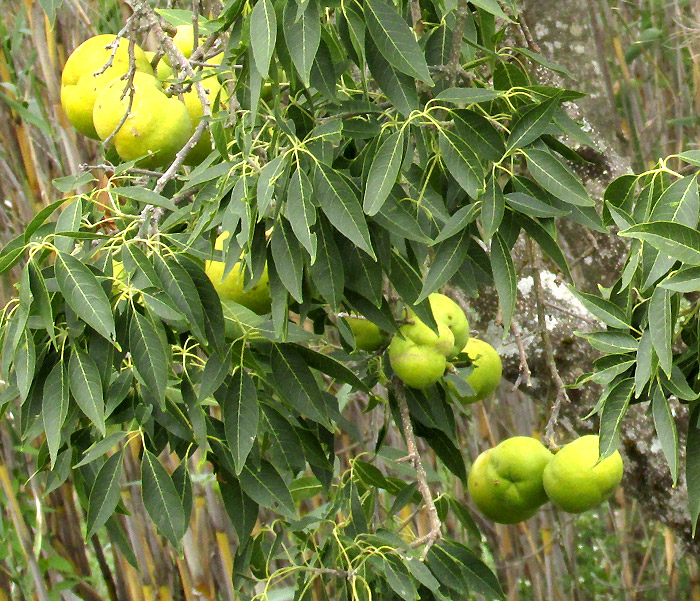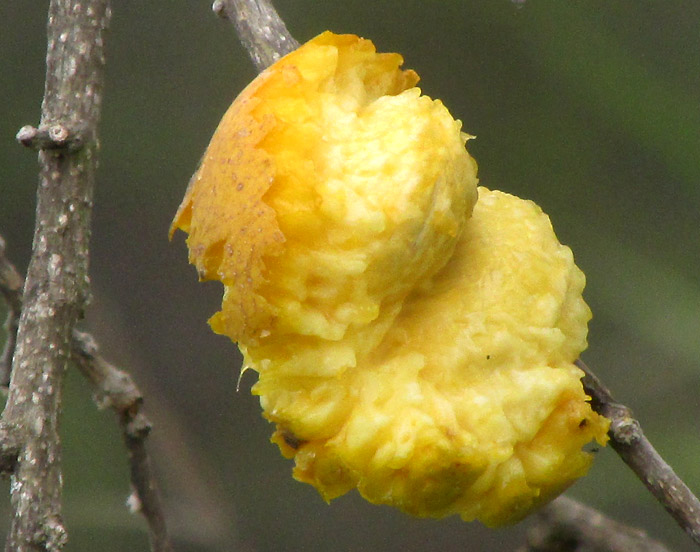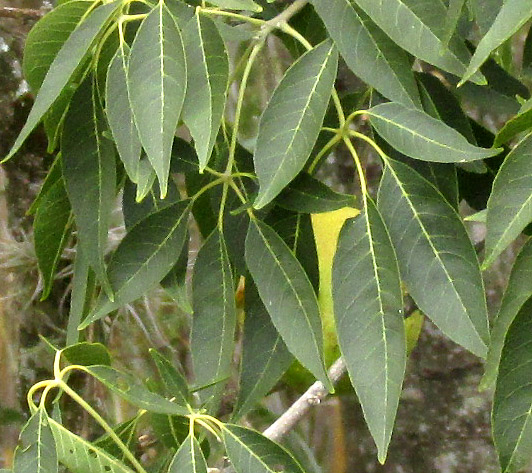Excerpts from Jim Conrad's
Naturalist Newsletter
Entry from field notes dated August 30, 2023, taken in Los Mármoles National Park, Hidalgo state, MÉXICO, about 1km upslope along road heading eastward out of the town of Trancas {on maps designated "Morelos (Trancas)"} toward Nicolás Flores; limestone bedrock; elevation ±2,100m (6900ft); (N20.80253°, W99.25756°)
WHITE SAPOTE

Beside the road out of Trancas, the above fruiting, mostly leafless tree occupied what may have been an abandoned or just neglected orchard, much overgrazed by wandering cattle, and suffering from this season's failed rainy season.

Though most branches were bare, several bore dense, green clusters of leaves and apple-size fruits. Note that the fruits' bottoms are somewhat indented, like an apple's, and in the picture's lower, right corner the star-shaped pattern of grooves suggests that the fruit is divided into five compartments, or locules. I paid attention to such details because I couldn't recognize the tree; nor could I get closer to it. I needed to "do the botany" at a distance. Fortunately, an animal, probably a woodpecker, had partially devoured a fruit, exposing its large seeds, as shown below:

Having a few large seeds instead of numerous small ones was informative, but a closer look at the leaves turned up something even more distinctive:

The leaves were palmately, or digitately, compound -- five or so slender leaflets all arising from one spot atop the petiole -- like fingers, or digits, radiating from a hand's palm. Even more surprising was that these digitately compound leaves arose singly on the stems, not in pairs of leaves opposite one another. Digitately compounds leaves arising opposite one another turn up on commonly known trees such as Ohio Buckeyes, but what plant family can produce trees bearing both spherical fruits and digitally compound leaves, with the leaves arising singly at each stem node?
Finally I remembered having encountered digitally compound leaves arising singly at each stem node on a flowering White Sapote tree back in the hot Yucatan lowlands. That species was Casimiroa tetrameria, of the Citrus Family, the Rutaceae. Usually we don't think of the Citrus Family with its lemon, orange and grapefruit trees as producing compound leaves, but this genus does.
Was this highland tree another White Sapote, this time fruiting? It turns out that our Hidalgo tree's leaves produce more slender leaflets on longer stalks, or petiolules. Here we had another species also known as White Sapote. It was the same genus as our Yucatan tree, but this was the much more famous CASIMIROA EDULIS.
Casimiroa edulis is native to the Mexican highlands south as far as Costa Rica. I read that it doesn't grow in the hot lowlands like our Yucatan White Sapote. However, the species is much planted for its delicious fruits in seasonally dry, cooler uplands worldwide. The species name edulis remarks on the fruit's edibility. Usually it's eaten raw, though the pulp also is used for flavoring in such commercial products as milkshakes and ice-cream. Several commercially sold cultivars have been developed with special traits, such as producing fruits at branch tips, and flowering and fruiting at different seasons.
The taxonomy of the White Sapotes, genus Casimiroa, isn't well understood. Some experts even think that our Yucatan Casimiroa tetrameria may be just a variant of our upland Hidalgo Casimiroa edulis. My experience so far suggests that these are two distinct species.
Kew's Plants of the World Online database tells us that the genus name Casimiroa was first published in 1825 by Mexican priest Pablo de La Llave and Mexican botanist Juan José Martínez de Lexarza (linked page in Spanish). The name honors Casimiro Gómez, of the Otomí indigenous people, whose home was the village of Cardonal here in Hidalgo state, Mexico. He fought and died in Mexico's war of independence against Spain, and at this time has no Wikipedia page. The genus name Casimiroa was for a long time thought to honor a Spanish botanist also named Casimiro Gómez, who does have a Wikipedia page. The home town of our Casimirio Gómez, Cardonal, lies only about 25 straight-line kms southeast of where our Hidalgo White Sapote occurs; we are truly in the homeland of the world-famous Casimiroa edulis.